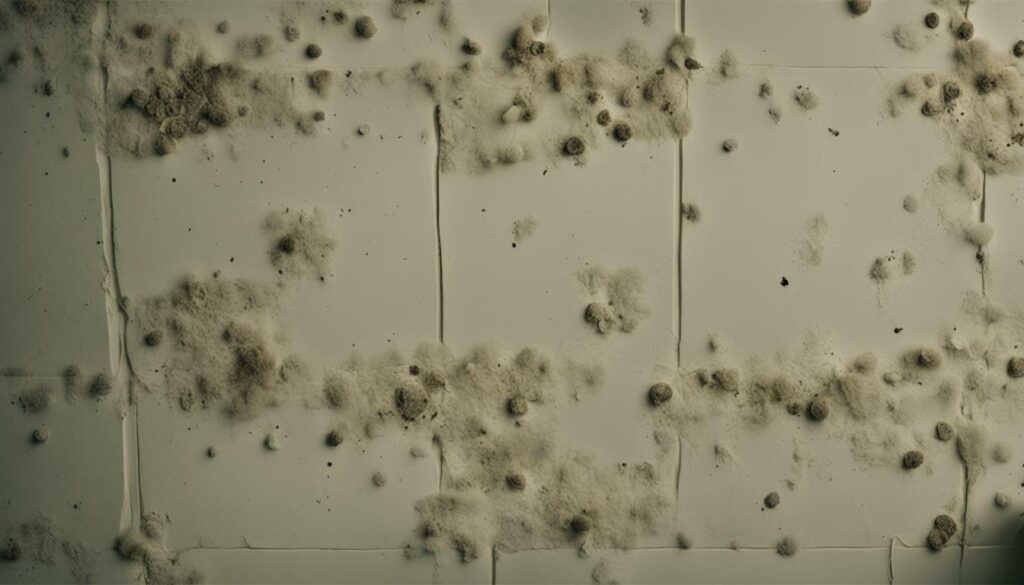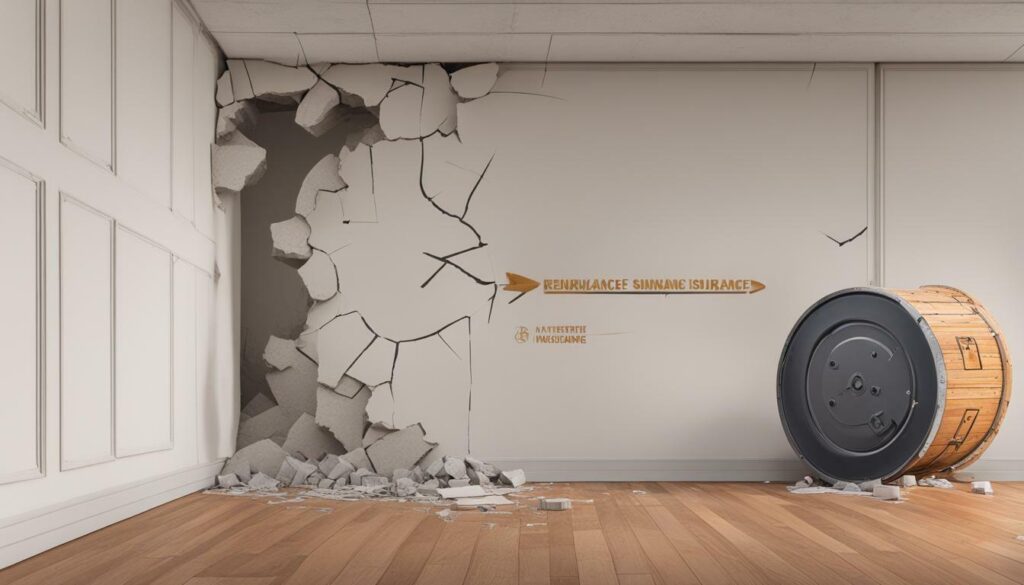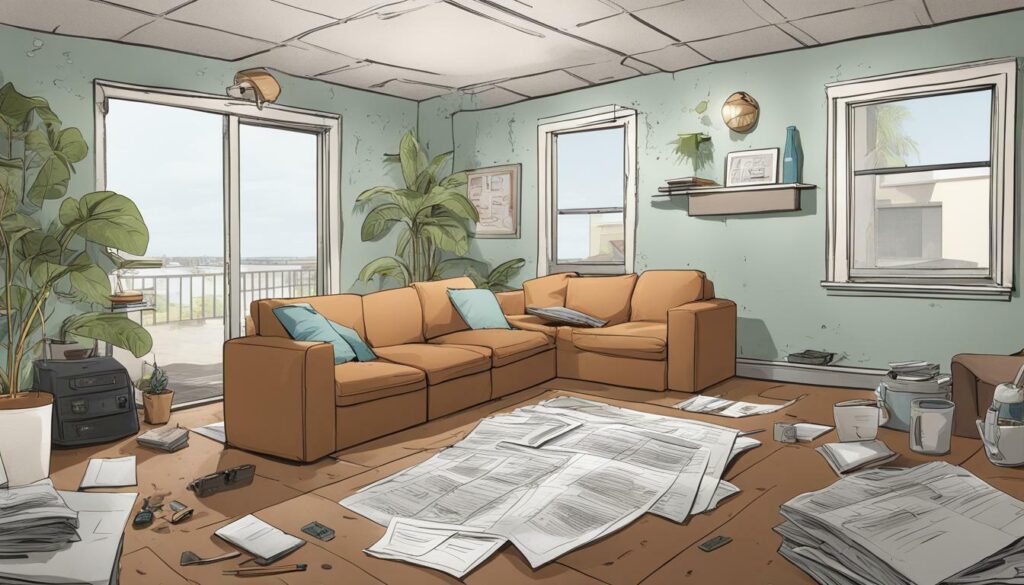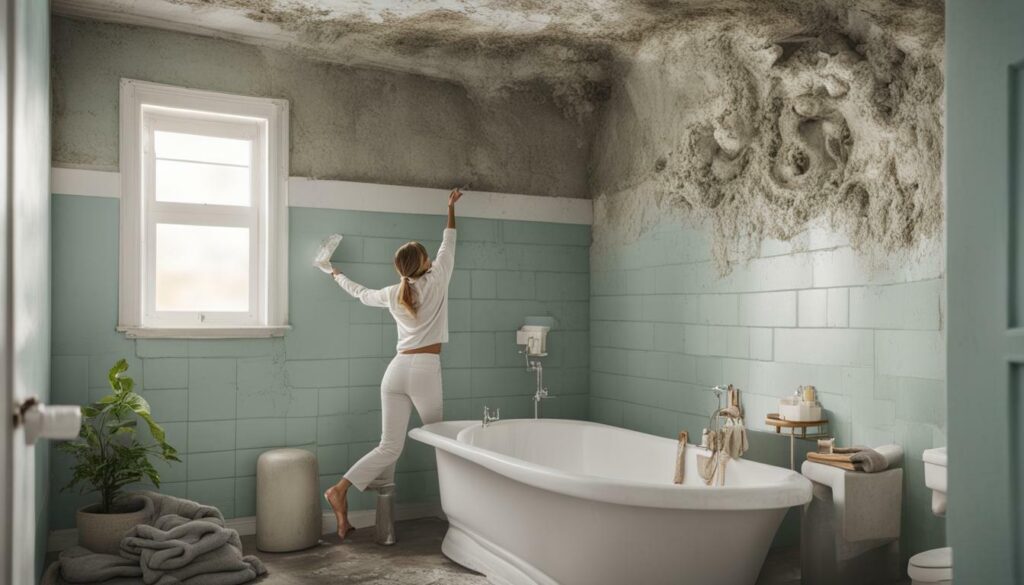If you’ve ever discovered mold growth in your home, you may have wondered if your homeowners insurance policy would cover the damage. Unfortunately, most standard homeowners insurance policies do not provide coverage for mold damage. This may come as a surprise, but there are reasons why mold is typically excluded from these policies.
Insurers consider mold to be a preventable issue that is related to home maintenance and upkeep. This means that homeowners are expected to take proper precautions to prevent mold growth, and insurance is meant to cover unforeseeable damages, like those caused by sudden and accidental events such as storms or fires.
Understanding why mold is excluded from homeowners insurance policies can help you take proactive measures to prevent mold growth in your home.
Key Takeaways:
- Most standard homeowners insurance policies do not provide coverage for mold damage.
- Insurers consider mold to be preventable and related to home maintenance.
- Taking proactive measures to prevent mold growth can help avoid costly damage and insurance issues.
Understanding mold claims and insurance policies
Dealing with mold damage in your home can be a frustrating and stressful experience. It’s important to understand how mold claims are typically handled by insurance companies, as well as the factors that can affect your coverage.
When it comes to insurance policies and mold damage, it’s important to know that homeowners insurance policies typically do not cover mold damage. This is because mold is considered a preventable issue that can be avoided with proper maintenance and upkeep of your home.
However, there are some situations where mold damage may be covered under your homeowners insurance policy. For example, if mold growth is the result of a covered peril, such as water damage from a burst pipe, the cost of mold remediation may be covered.
It’s also important to note that some insurance companies offer limited coverage for mold damage as an add-on endorsement to your homeowners insurance policy. This coverage may come with higher premiums and specific limitations, so it’s important to read the fine print carefully.
If you do find yourself dealing with mold damage in your home, it’s important to file a claim with your insurance company as soon as possible. Your insurance company will likely send out an adjuster to assess the damage and determine if it is covered under your policy.
It’s important to document all damage and keep records of any expenses incurred as a result of the mold growth. This will help with the claims process and ensure that you receive the appropriate coverage.
Overall, understanding mold claims and insurance policies can be complicated. It’s important to read your policy carefully and consult with your insurance company if you have any questions or concerns.


Common Exclusions in Homeowners Insurance Policies
When it comes to homeowners insurance, it’s important to note that not all types of damage are covered. There are several common exclusions that you should be aware of, including the specific exclusion for mold damage.
Typically, homeowners insurance policies will only cover sudden or accidental damage to your property, such as damage caused by a burst pipe or a fallen tree. However, damage that occurs gradually over time, like mold growth, is typically not covered.
The reason for this exclusion is that mold growth is often seen as a preventable issue that can be avoided through proper maintenance and upkeep of your home. Insurance companies view mold as a result of neglect rather than an unforeseeable circumstance.
It’s important to note that even if your insurance policy does cover mold damage, there may be limits to the coverage amount or specific requirements that must be met in order for the damage to be covered. For example, some policies may only cover mold damage if it was caused by a covered peril, such as a burst pipe or a roof leak.
Be sure to review your homeowners insurance policy carefully and speak with your insurance agent to fully understand what is and is not covered in terms of mold damage.


The Impact of Mold on Property and Health
Mold growth in your home can have serious consequences for both your property and your health. When mold is allowed to proliferate unchecked, it can damage the structure of your home, weaken walls and ceilings, and compromise the safety of your living space. Additionally, mold spores can lead to a range of health problems, from respiratory issues to allergic reactions, particularly for those with pre-existing conditions.
It’s important to take mold growth seriously and take steps to prevent it from occurring in the first place. Doing so can also impact your insurance coverage. By taking proactive measures to prevent mold growth, such as fixing leaks or improving ventilation, you may be able to avoid costly mold removal expenses and maintain your insurance coverage.
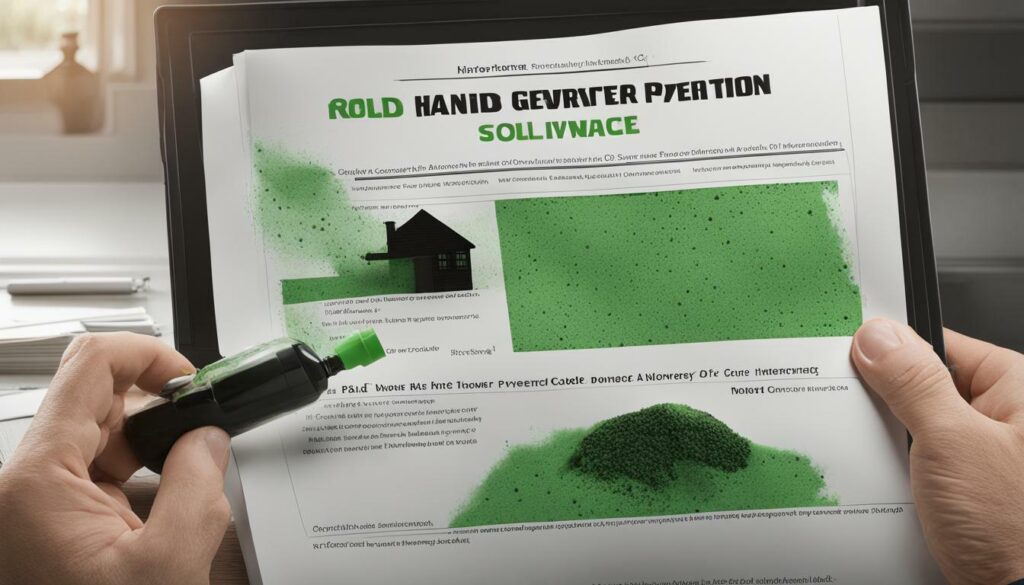

When dealing with mold issues, it’s important to work with professionals who have experience in mold remediation. Attempting to remove mold yourself can not only be dangerous, but also cause further damage to your property. By working with trained professionals, you can ensure that the mold is removed safely and effectively, minimizing the risk of additional property damage or health complications.
Be sure to keep accurate records of any mold-related issues in your home, including dates, descriptions of the problem, and any documentation of professional remediation efforts. Should you need to file an insurance claim for mold damage in the future, having detailed records can help streamline the claims process and increase your chances of receiving adequate coverage.
The Importance of Mold Prevention
If you want to minimize the risk of mold damage in your home, prevention is key. Not only can mold growth cause property damage and health issues, but it can also impact your insurance coverage. Here are some effective tips to help you prevent mold growth and stay protected:
- Control moisture: Mold requires moisture to grow, so it’s important to keep your home dry. Fix any leaks or water damage immediately, and use dehumidifiers and ventilation to reduce humidity levels.
- Clean and maintain: Regularly clean and maintain your home to prevent mold growth. This includes wiping down surfaces, vacuuming carpets and upholstery, and washing bedding and towels.
- Proper ventilation: Make sure your home has proper ventilation in high-moisture areas such as bathrooms, kitchens, and laundry rooms. Use exhaust fans or open windows to circulate air and reduce humidity.
- Inspect regularly: Inspect your home regularly for signs of mold growth, such as musty smells or discoloration on walls or ceilings. If you suspect mold, take action immediately to prevent further damage.
By taking these steps, you can minimize the risk of mold growth and protect your home and insurance coverage. Remember, prevention is always better than cure when it comes to mold.


Mold Insurance Claims Process
If you discover mold damage in your home, it’s important to understand the mold insurance claims process so you can file a claim and get the coverage you need to remediate the issue. Here are the steps you’ll need to follow:
- Contact your insurance company: Call your insurance company as soon as you notice the mold damage. Be prepared to provide details about the extent of the damage and how it occurred. Your insurance company will assign an adjuster to your claim, who will be your primary contact throughout the process.
- Document the damage: Take photos or videos of the mold damage, as well as any visible signs of water damage that may have contributed to the mold growth. Keep records of all communication with your insurance company, including emails and phone calls.
- Work with the adjuster: Your adjuster will investigate the mold damage and determine whether your policy covers the damage. They’ll also provide you with an estimate of the cost of repairs and remediation.
- Get estimates for remediation: You’ll need to get estimates from licensed mold remediation professionals for the cost of repairs and remediation. Your insurance company may have a list of approved contractors you can use.
- Approve the estimate: Once you’ve received the estimate, you’ll need to approve it before the remediation work can begin. Your insurance company may also need to approve the estimate before work can commence.
- Pay your deductible: You’ll need to pay your deductible before your insurance company will cover the remaining cost of the remediation work.
- Remediation: The licensed remediation professionals will then begin the remediation work. Your insurance company may send an adjuster to oversee the remediation process to ensure it’s being done correctly.
- Final inspection: After the remediation work is complete, your adjuster will perform a final inspection to ensure the mold has been properly removed. Once they’ve signed off on the work, the claim will be closed.
Remember, the mold insurance claims process can be complex, so it’s important to work closely with your insurance company and the licensed remediation professionals to ensure everything is handled properly. By following these steps, you can get the coverage you need to remediate the mold damage in your home and ensure your family’s health and safety.
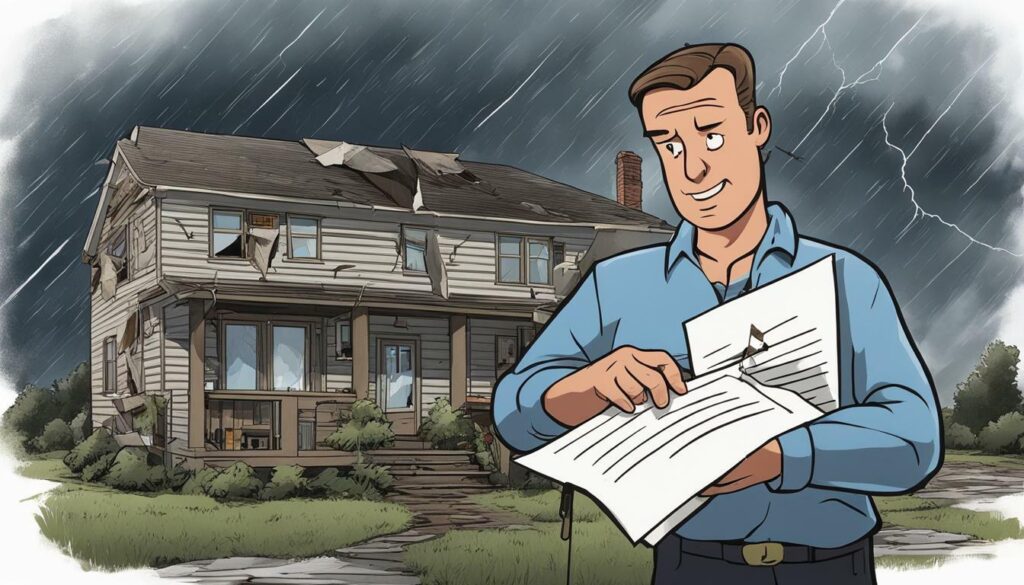

Alternative coverage options for mold damage
While homeowners insurance typically excludes mold damage, there are alternative coverage options to consider. Specialized mold insurance policies or endorsements can provide coverage for mold-related losses and damages. These policies are designed specifically to address the unique risks associated with mold growth in homes.
When exploring alternative coverage options, it’s important to understand the specifics of the policy and what types of mold damage are covered. Some policies may have exclusions or limitations, so be sure to carefully review the terms and conditions before making a decision.
Working with an experienced insurance agent can be helpful in identifying the right coverage options for your needs. They can help you understand the nuances of different policies and make informed decisions about your coverage.
Keep in mind that some insurance companies may require proof of preventative measures, such as regular inspections and maintenance, to qualify for mold coverage. It’s important to take proactive steps to prevent mold growth in order to ensure that you are eligible for coverage in the event of a mold-related loss.
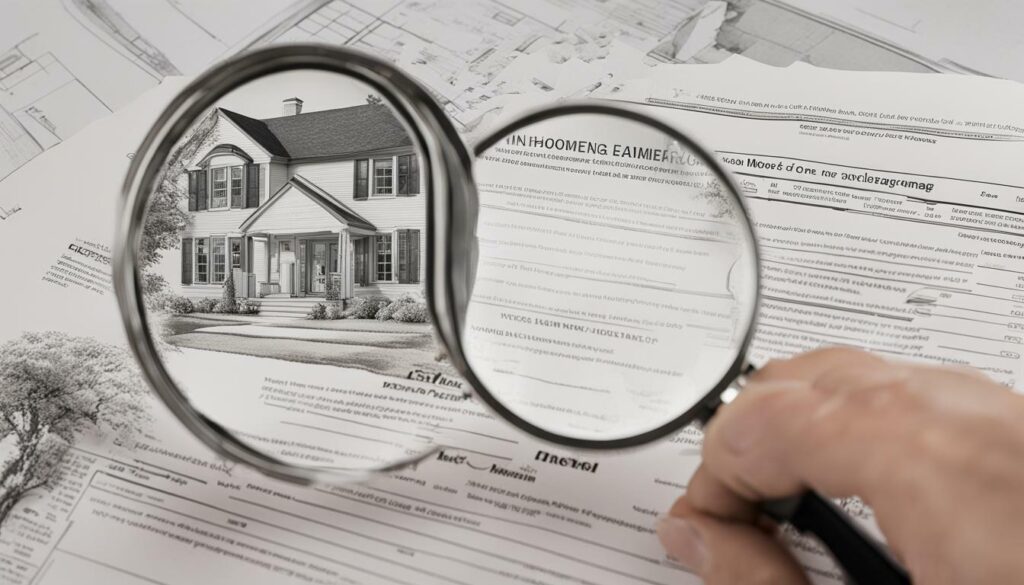

By exploring alternative coverage options and taking preventative measures, you can protect your home and personal belongings from the potential risks and consequences of mold damage. Consult with your insurance agent to determine the right coverage for your needs and take the necessary steps to prevent mold growth in your home.
The Cost of Mold Remediation
Dealing with mold damage can be a costly affair, and it is essential to understand the potential expenses involved. Depending on the extent of the mold growth, remediation costs can range from a few hundred to several thousand dollars. In some cases, insurance coverage may help offset some of these costs, but it is essential to understand the coverage limitations.
Insurance policies typically cover mold damage only if it is a result of a covered peril, such as water damage caused by a burst pipe. However, if the mold damage is due to long-term neglect or poor maintenance, it is unlikely to be covered. Additionally, policies may have coverage limits and deductibles, which can impact the amount you receive in compensation.
When filing an insurance claim for mold damage, be sure to document the extent of the damage and keep detailed records of any expenses related to remediation. Your insurance adjuster may require this information to process your claim.
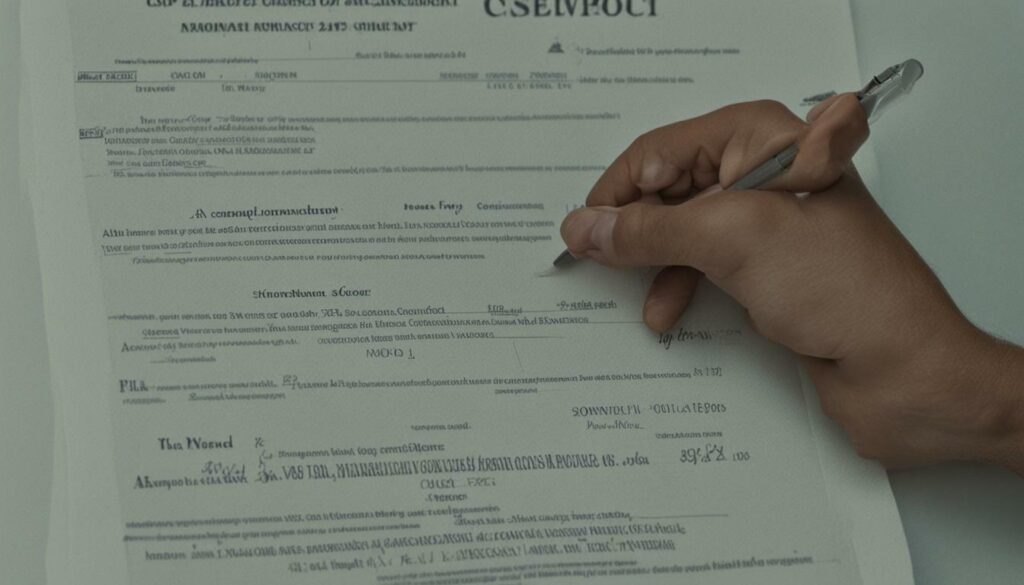

It’s important to note that insurance companies may have specific guidelines for addressing mold damage, and it may be necessary to work with a licensed mold remediation specialist to ensure proper and effective treatment. In some cases, insurance companies may have preferred vendors or contractors that must be used for remediation services.
To minimize the cost of mold remediation, it’s essential to address any water damage or leaks promptly and thoroughly. Regular maintenance and inspections can also help identify any potential mold growth early, allowing for timely remediation and prevention of further damage.
Tips for Dealing with Mold Issues
If you suspect mold growth in your home, it’s important to take action as soon as possible to prevent further damage and potential health risks. Here are some tips for dealing with mold issues:
- Identify the source: Determine the source of the moisture that is causing the mold growth. Fixing the source of the moisture is crucial to preventing further mold growth.
- Call a professional: If the mold growth is widespread or if you are unsure of how to handle it, it’s best to call a professional mold remediation company to assess the situation and provide guidance on how to properly remove the mold.
- Document the damage: Keep detailed records of any damage caused by the mold, including photographs and receipts for any expenses related to cleanup or repairs.
- Inform your insurance company: Contact your insurance company to report the damage and determine if your policy provides coverage for mold remediation. Keep in mind that mold coverage is typically excluded from standard homeowners insurance policies, but it may be available as an endorsement or a separate policy.
- Prevent future mold growth: Take steps to prevent future mold growth by addressing any moisture issues in your home, such as fixing leaks, improving ventilation, and using a dehumidifier in damp areas.
By following these tips, you can effectively deal with mold issues in your home and potentially reduce the impact on your insurance coverage.
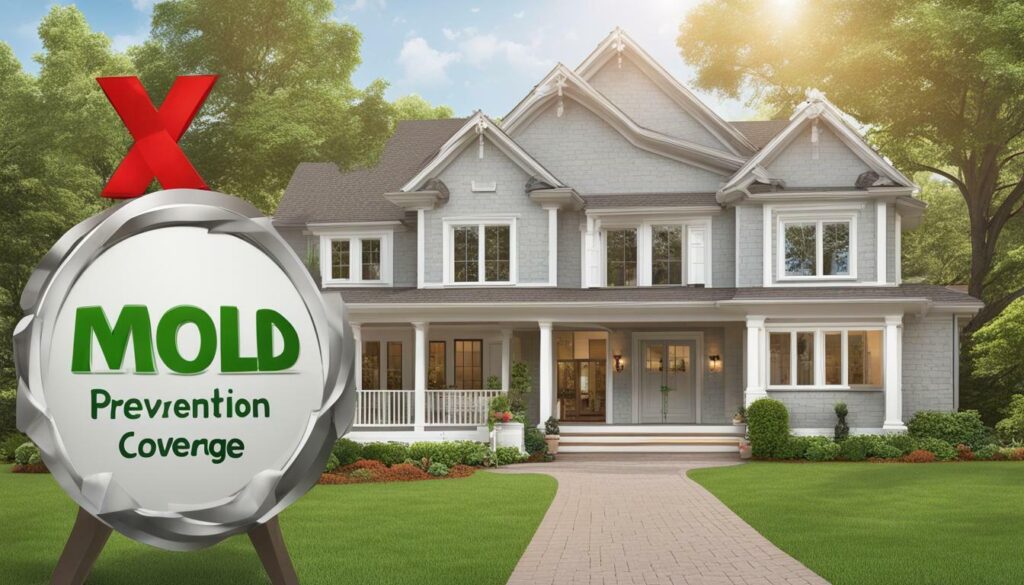

Making Informed Decisions About Mold Coverage
If you’re a homeowner, it’s important to understand the limitations of your homeowners insurance policy when it comes to mold coverage. As we’ve discussed, most policies exclude mold damage from coverage, which means that you may need to explore alternative options for protection.
One potential solution is to purchase a specialized mold insurance policy or endorsement. These policies are designed specifically to provide coverage for mold damage and may offer more comprehensive protection than a standard homeowners insurance policy. However, it’s important to carefully review the terms and conditions of any policy you’re considering to ensure that it meets your needs and budget.
Another option is to focus on preventative measures to minimize the risk of mold growth in your home. By taking proactive steps to address moisture and ventilation issues, you can reduce the likelihood of mold damage and potentially avoid the need for insurance coverage altogether.
Ultimately, the decision about whether or not to invest in mold coverage will depend on your individual circumstances and risk tolerance. However, by understanding the options available to you and taking steps to protect your home, you can make informed decisions that will help to safeguard your property and your peace of mind.
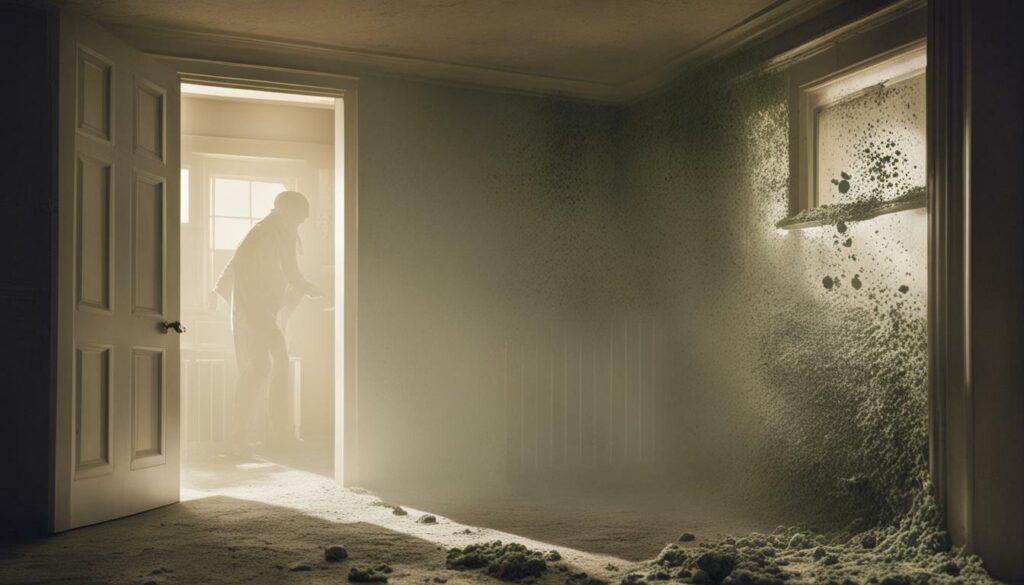

Conclusion
As a homeowner, it is important to understand the limitations of your insurance policy when it comes to mold damage. Homeowners insurance typically does not cover mold damage, and it is crucial to take proactive measures to prevent its growth in your home.
By following the tips and strategies outlined in this article, such as keeping your home well-ventilated and addressing any leaks or moisture issues promptly, you can help reduce the risk of mold growth and potential property damage or health issues.
However, should you experience mold damage, it is important to understand the claims process and the potential costs associated with remediation. Consider alternative insurance options, such as specialized mold insurance policies or endorsements, to ensure you have adequate coverage.
In summary, taking steps to prevent mold growth and making informed decisions about insurance coverage can help protect your home and your family from the harmful effects of mold.
FAQ
Q: Why doesn’t homeowners insurance cover mold?
A: Homeowners insurance typically does not cover mold damage because it is considered a preventable and ongoing issue. Mold is often seen as a result of negligence or poor maintenance, rather than a sudden and accidental event, which is what insurance policies typically cover.
Q: How are mold claims handled by insurance companies?
A: Mold claims are handled differently by insurance companies. Some policies may offer limited coverage for mold damage, while others may exclude it entirely. It is important to review your insurance policy and understand the specific terms and coverage related to mold.
Q: What are common exclusions in homeowners insurance policies?
A: Common exclusions in homeowners insurance policies include damage caused by mold, as well as other issues like flooding, earthquakes, and routine wear and tear. These exclusions may vary depending on the specific policy and insurance provider.
Q: What is the impact of mold on property and health?
A: Mold can cause significant damage to property, including structural issues and compromised indoor air quality. In terms of health, exposure to mold can lead to respiratory issues, allergies, and other potential health problems.
Q: How can mold growth be prevented?
A: Mold growth can be prevented by maintaining proper ventilation, controlling humidity levels, addressing water leaks or moisture issues promptly, and ensuring proper drainage around the property. Regular inspections and maintenance can also help prevent mold growth.
Q: What is the mold insurance claims process?
A: The mold insurance claims process typically involves documenting the damage, contacting your insurance company, working with an adjuster, providing necessary documentation, and following the insurer’s guidelines for remediation and repairs.
Q: Are there alternative coverage options for mold damage?
A: Some insurance companies offer specialized mold insurance policies or endorsements that provide coverage for mold damage. These options may be worth considering if you live in an area prone to mold or if you have had previous mold issues in your home.
Q: What is the cost of mold remediation?
A: The cost of mold remediation can vary depending on the extent of the damage, the size of the affected area, and the specific services required. Insurance coverage for mold remediation may vary, so it’s important to consult your policy or speak with your insurance provider directly.
Q: What are some tips for dealing with mold issues?
A: When dealing with mold issues, it is recommended to contact professionals experienced in mold remediation. Keep accurate records of the damage and any expenses incurred, and follow the advice and guidelines provided by your insurance company.
Q: How can I make informed decisions about mold coverage?
A: To make informed decisions about mold coverage, review your homeowners insurance policy, understand the exclusions and limitations related to mold, consider the potential risks and costs associated with mold damage, and explore alternative coverage options if necessary.

